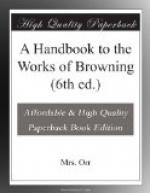“FILIPPO BALDINUCCI” was the author of a history of art ("Notizie dei Professori del Disegno da Cimabue in qua"); and the incident which Mr. Browning relates as “a reminiscence of A.D. 1670,” appears there in a notice of the life of the painter Buti. (Vol. iii. p. 422.)
The Jewish burial ground in Florence was a small field at the foot of the Monte Oliveto. A path ascending the hill skirted its upper end, and at an angle of this stood a shrine with one side blank, the other adorned by a painting of the Virgin Mary. The painting was intended to catch the eye of all believers who approached from the neighbouring city-gate (Porta San Friano or Frediano); and was therefore so turned that it overlooked the Jewish cemetery at the same time. The Jews, objecting to this, negotiated for its removal with the owner of the ground; and his steward, acting in his name, received a hundred ducats as the price of his promise that the Virgin should be transferred to the opposite side of the shrine. The task was undertaken by Buti, but carried on in the privacy of a curtained scaffolding; and when the curtains were withdrawn, it was seen that the picture had been transferred; but that a painting of the Crucifixion occupied its original place. Four Rabbis, the “sourest and ugliest” of the lot, were deputed to remonstrate with the steward; but this person coolly replied that they had no ground of complaint whatever. “His master had amply fulfilled his bond. Did they fancy their ‘sordid’ money had bought his freedom to do afterwards what he thought fit?” And he advised them to remove themselves before worse befell them. The Jews retired discomfited; and, as the writer hopes, took warning by what had happened, never again to tempt with their ill-earned wealth “the religious piety of good Christians.”
Mr. Browning gives this story, with unimportant variations, in the manner of Baldinucci himself; and does full justice to the hostile and contemptuous spirit in which the attitude of the Jews is described by him. But he also heightens the unconscious self-satire of the narrative by infusing into this attitude a genuine dignity and pathos. He enlists all our sympathy by the Chief Rabbi’s prayer that his people, so sorely tried in life, may be allowed rest from persecution in their graves; and he concludes with an imaginary incident which leaves them masters of the situation. On the day after what the historian calls this “pleasing occurrence,” the son of the High Priest presented himself at Buti’s shop, where he and the so-called “farmer” were still laughing over the event; and in tones of ominous mildness begged to purchase that pretty thing—the picture in oils, from which the fresco painting of the Virgin had been made. He was a Herculean young man, and Buti, who white and trembling had tried to slip out of his way, was so bewildered by the offer, that he asked only the proper price for his work. The farmer, however, broke forth in expressions of pious delight, “Mary had surely wrought a miracle, and converted the Jew!”




